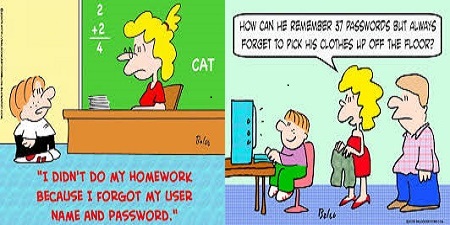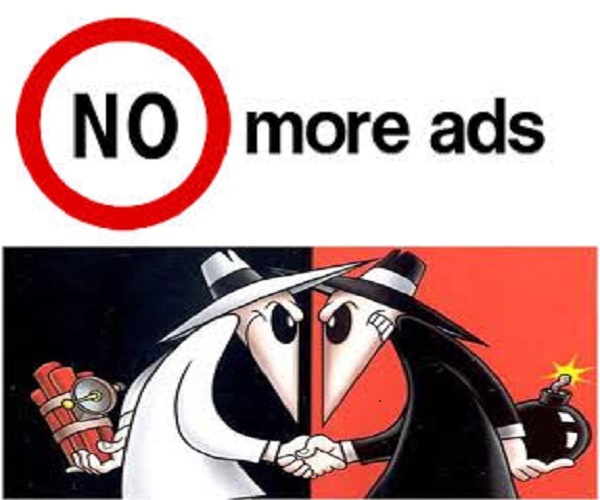Even the most TV-averse person in the USA has likely heard of Late Show host David Letterman’s “Stupid Pet Tricks” which ran for 30 years. So there were probably as many people who watched at least one episode of it as have had some sort of trouble choosing and/or using passwords on the Internet. Unfortunately, the formats of passwords have recently become a lot more demanding and the organizations forcing us to have passwords have made us run a truly nasty gantlet (look it up!). The nastiness seems to be a recent phenomenon, perhaps a result of all the major hacking attacks in the last few months. One of the latest dirty tricks is to provide two boxes, one for entering the password (which blanks out your entry) and another for confirming it (which also blanks out your entry), as well as a third alternative of letting the organization create the password for you. As you make the first entry, you get nasty comments that your password is not strong enough, forcing you to make changes until you have satisfied the demand. Even if you have carefully noted the approved password, by now it is a challenge to enter it exactly in the confirmatory box. And people are now finding that, in fact, these organizations do not want you to select your own password, and you MUST let the organization chose one for you. It is not the end of the world, but (a) if you have your own system for creating passwords you will NEVER succeed in getting one, and (b) why bother to offer to let you create your own? At least David Letterman’s Stupid Pet Tricks was funny, while this latter-day password game is definitely NOT funny. Sadistic maybe. Even worse, the possibility of using a hardware “dongle” continues to be remote, in large part because there is no apparent convergence to a standard.
Tag Archives: Self-serving
Will There be a Useful Truce Among Ads and Ad Blockers and Ad Blocker-Blockers?
History buffs may liken this situation to the spy-and-counter-spy among countries. It surely seems to us at Technology Bloopers to be a great waste of resources and a great inconvenience to the more than 3 billion current users of the Internet today. Most users have already been spoiled by the “free” goodies they enjoy in return for their viewing increasing volumes of advertising. This arrangement has been around for at least 150 years in newspaper and magazine publishing, although most of the important hard-copy publications make their revenue from a combination of subscription fees and advertising purchases. By contrast, the much more recent Internet is mostly free to users and paid for by advertisers. Some interesting exceptions are Wikipedia, language-learning site Yabla, and purchase or rental of plugins and themes for WordPress. In the opinion of Technology Bloopers, there are many Internet sites for which users would pay reasonable fees, which would reduce the conflict among the titans of Silicon Valley. Google has contributed great gobs of technology but financed it heavily with ads. But users have had their fill of ads, leading to a rapid growth of ad blocking software. And some of the ads are so intrusive (the ones on SpanishDict.com are the worst in our experience, interrupting users with highly-distracting audio and video) that they cry out for ad blockers … and boycotting of such sites in favor of more ones that are less obnoxious. The advertisers have been spooked by this software, leading to a rapid growth of software that undoes the blocking. Most recently Apple has jumped into the fray with its own ad blockers, which is a welcome counter-force, though actually Apple has its own ads buried in its Apps, so the only beneficiary is Apple, while Google loses business and consumers continue to be annoyed by ads.
The Most Insidious Advertisement We’ve Seen (So Far)
Few would dispute the great usefulness of Google search. And most of us are willing to put up with the numerous ads that come along with the content. They are usually a small price to pay for the convenience and completeness of the information we seek. And we rarely have a choice of ads + free content vs. paid content. Sometimes the ads are distracting and/or invasive (especially ones with audio, video, or animation). But perhaps the worst ads are the ones that don’t look like ads at all. For example, the one in the graphic above, which is formatted to look just like the usable content itself. This strains the limits of ethics; at least in paper periodicals the advertisements are either clearly advertisements (as is easily seen by their formats) or are clearly labeled “ADVERTISEMENT”. Unless you truly need the content you found, we urge you to peruse other, more ethical, websites for your information needs. (It was interesting that we found this on a website dealing with CAPTCHA’s, which is another phenomenon of dubious merits.)
ICANN.sucks
Billions of Internet users are familiar with the suffixes of website names like .com, .net, and .org, which were among the first of the gLTD’s (Generic Top-Level Domains). With the growth in numbers of website names has come a growth in suffixes, both to allow for the growth and to provide hints as to the nature of the websites (e.g., .edu, .gov, and .mil). Makes sense, right. But what were they (Internet Corporation for Assigned Names and Numbers) thinking when they added “.sucks” to the list of gLTD’s? Had they never heard of Murphy’s Law (“If anything can go wrong, it will.”)? Within microseconds countless Internet denizens around the world, at least those with US$2,500 to spare, were contacting Vox Populi to get ready to heap abuse on their favorite villains. Fortunately, cooler heads have prevailed and ICANN has backed away from their ill-advised largesse.
Bears Make Money, Bulls Make Money, But Pigs Get Slaughtered
Tech companies would do well to heed this time-proven advice to investors. They are truly greedy these days, forcing themselves on users. The most recent push-back by a journalist that we’ve seen is from Patric May at the San Jose MercuryNews, who tried to unsubscribe from the firehose of unwanted emails he was receiving. One thing he learned was that using “Unsubscribe” was like pouring gasoline on a fire, because it confirmed a valid email address to the sender, who could then sell it to dozens or hundreds of other companies, all of whom could then bombard him with THEIR emails.
There are lots of other self-serving ploys from other companies. Does Dropbox really care all that much to protect your files by reminding you to use it, or is it because they want you to use a lot of storage that they can charge you for? And why else did they immediately upload all your photos to their site other than filling up your “free” storage so they could start charging you for the additional storage. Apple does the same thing to a new iPhone, whether you want them to or not. Did you really want your thousands of carefully-cataloged photos dumped into a single big tub? We thought not.





